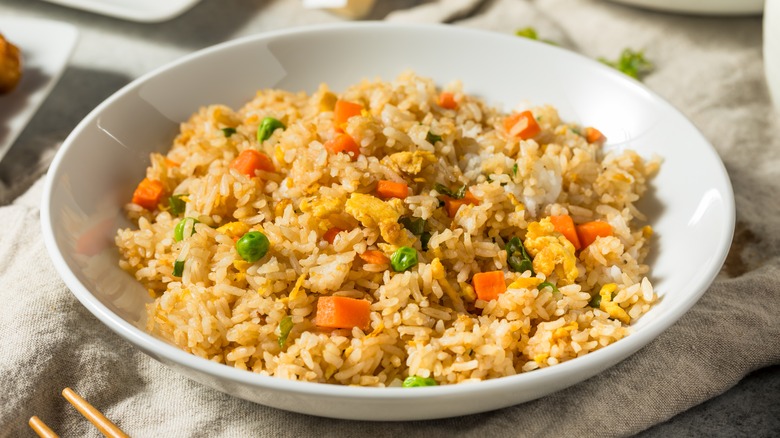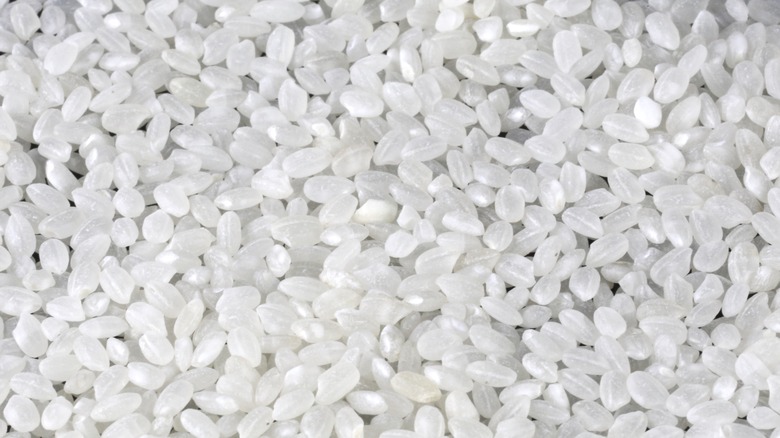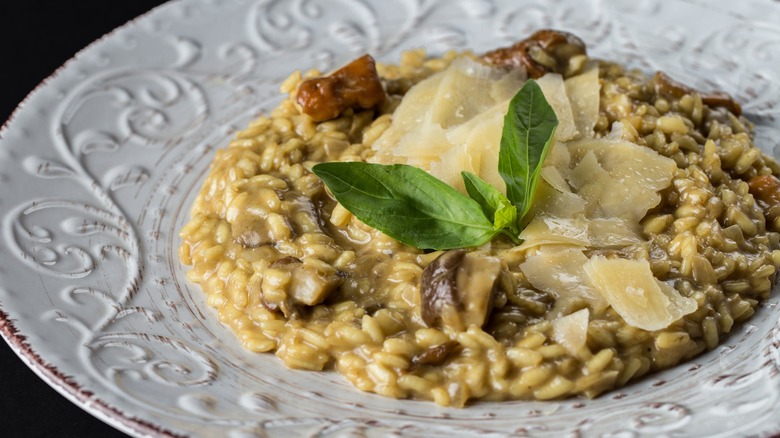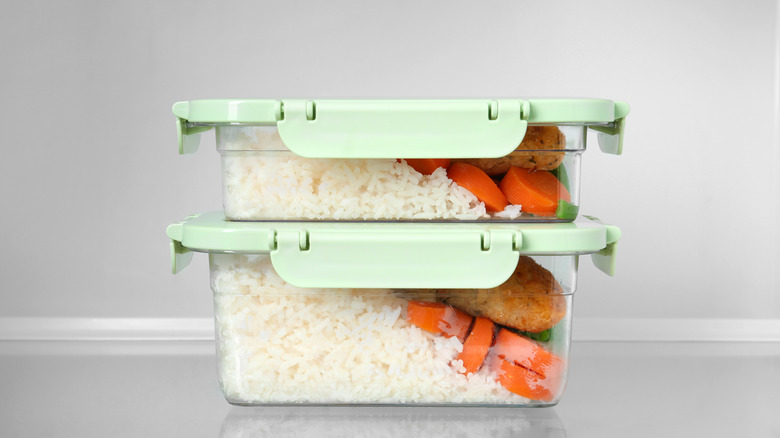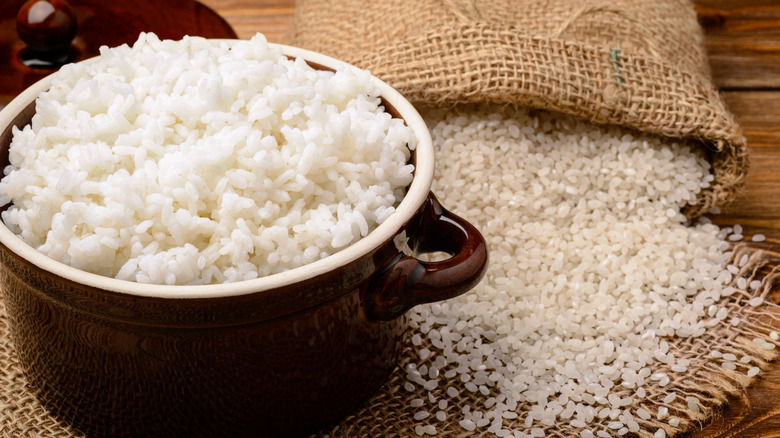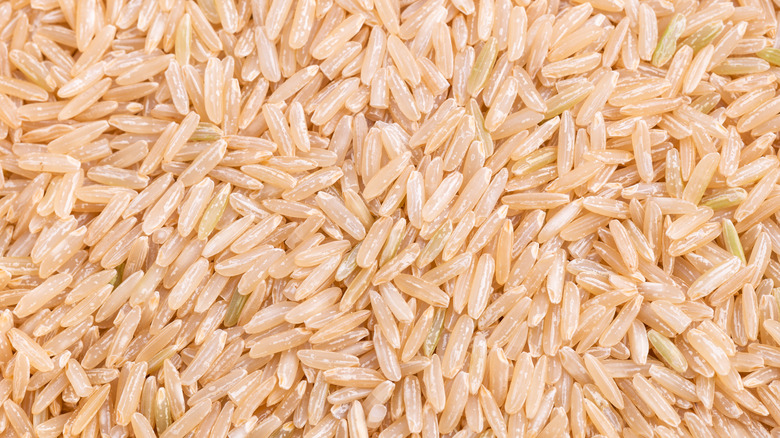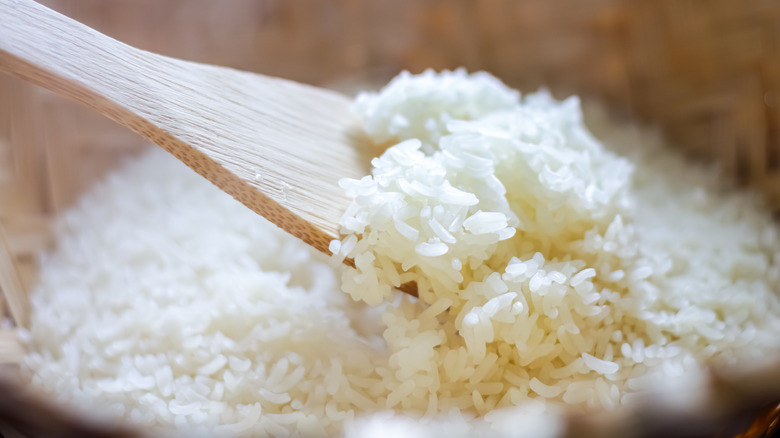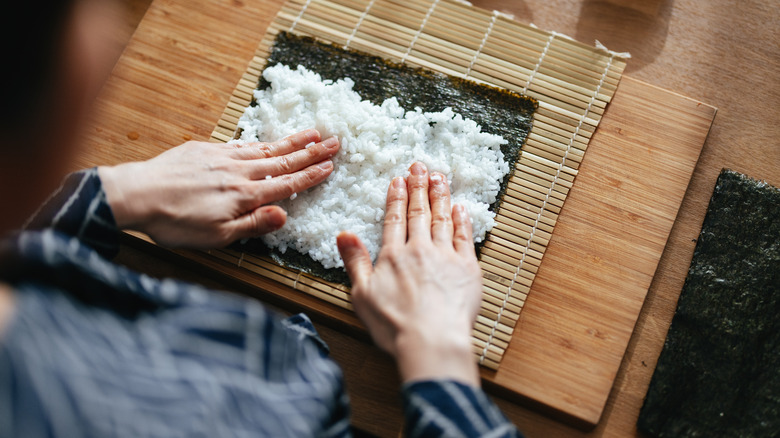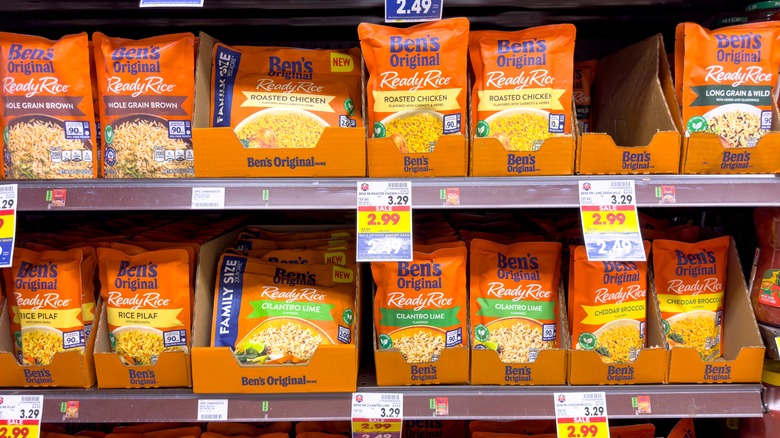The 5 Absolute Best Types Of Rice For Fried Rice And 5 Others To Avoid
I've spent a lot of time trying to perfect the art of fried rice, and one thing is clear: The rice you choose can make or break the dish. The texture is everything — if the rice is too sticky or too soft, your fried rice will end up a soggy mess instead of the crispy, flavorful stir-fry you're aiming for. Some rice varieties hold up beautifully in the pan, giving you that perfect balance of chewiness and crispness, while others will leave you with a disappointing, clumpy result that lacks the vibrant texture fried rice is known for.
In this guide, I've selected the best rice varieties for fried rice based on key factors like texture, moisture content, and how well they hold up during stir-frying. The ideal rice should be firm, slightly chewy, and non-sticky to ensure each grain crisps up evenly and remains separate. On the flip side, rice types that are overly sticky, mushy, or lacking in structure were categorized as ones to avoid for fried rice.
Whether you're going for a classic fried rice or adding your own creative twist, choosing the right rice is essential to achieving that restaurant-quality fried rice. Let's dive into the best options for fried rice and the rice types that are best left out of the wok.
Best: Jasmine rice
Jasmine rice is a top choice for fried rice, thanks to its light, fragrant aroma and perfect texture. Known for its long, slightly sticky grains, jasmine rice maintains a fluffy yet slightly chewy consistency when stir-fried, making it an ideal base for any fried rice dish. The grains don't clump together easily, which is key for fried rice — you want each bite to have individual grains that are lightly crisped, not a sticky mound.
Another benefit of jasmine rice is its subtle floral scent, which adds an extra layer of flavor without overpowering the dish. This delicate aroma complements the savory elements of fried rice, enhancing the overall taste experience. Jasmine rice works beautifully in traditional fried rice recipes, and its flavor and texture hold up well even when you're adding proteins like chicken, shrimp, or pork.
One thing to note is that jasmine rice's naturally lower starch content helps it fry up well without becoming overly greasy or heavy. This makes it especially good for recipes where you want the rice to absorb sauces and seasonings while keeping its structure intact. Its versatility also extends to vegetarian versions of fried rice, where its lightness allows vegetable flavors to really shine. Whether you're going for a classic take on fried rice or putting your own spin on it, jasmine rice's balance of aroma, texture, and taste makes it one of the best rice varieties to use.
Avoid: Short-grain rice
When it comes to fried rice, short-grain rice is best avoided. Known for its high starch content, short-grain rice tends to be sticky and clumpy, which is far from ideal for fried rice. Instead of individual grains that separate and crisp up in the pan, short-grain rice often results in a gummy, overly dense texture that doesn't allow for the proper stir-frying process.
The main problem with short-grain rice is that its high starch content causes the grains to stick together during cooking, making it difficult to achieve the light, crispy texture that defines good fried rice. This clumping makes the dish feel heavy and gluey rather than light and flavorful. While short-grain rice works well in dishes where a sticky texture is desired, such as sushi or rice puddings, it simply doesn't perform well in a fried rice setting.
Additionally, the stickiness of short-grain rice can make it less absorbent of the sauces and seasonings properly, which further compromises the flavor and texture of the dish. The rice tends to form clumps that are difficult to break apart, meaning the flavors won't distribute evenly. This leads to pockets of bland rice instead of the well-seasoned grains you're aiming for in fried rice.
For the best results, stick to long-grain or medium-grain rice varieties that allow the grains to separate and crisp up beautifully. Short-grain rice may have its place in other recipes, but for fried rice, it's one to avoid.
Best: Basmati rice
Basmati rice is another excellent option for fried rice, thanks to its long, slender grains and naturally firm texture. Known for its non-sticky consistency, basmati rice holds up beautifully in the stir-frying process, ensuring that each grain remains separate and light. This makes it a perfect choice for fried rice, where you want the grains to crisp up and absorb the flavors of your dish.
One of the best qualities of basmati rice is its ability to stay firm without becoming mushy. While some rice varieties might break down or clump together when stir-fried, basmati's structure remains intact, giving you a perfect fried rice texture. It's also naturally aromatic, with a slightly nutty flavor that adds a subtle complexity to your fried rice. The flavor is mild enough not to overpower your dish but adds an extra dimension that enhances the overall taste.
Basmati rice is particularly well-suited for dishes that include bold sauces and proteins, as its firm grains absorb seasonings without becoming soggy. Whether you're making a vegetable fried rice, chicken fried rice, or adding shrimp to the mix, basmati rice provides the perfect canvas for all kinds of ingredients.
Avoid: Arborio rice
Arborio rice is a well-known variety used primarily for creamy dishes like risotto, but when it comes to fried rice, it's a poor choice. Arborio's high starch content gives it a soft, creamy texture when cooked, which is great for creating a luxurious, rich risotto — but not ideal for fried rice. The creaminess that makes arborio perfect for absorbing flavors in risottos becomes a liability in fried rice, where you want each grain to remain separate and crisp.
Because of its short, plump grains, arborio rice tends to become too mushy and sticky during the stir-frying process. The result is a dense, overly thick texture that doesn't achieve the light, airy feel essential to good fried rice. Instead of crisp, distinct grains, you're left with clumps of soft rice that make the dish heavy and unappealing.
Another issue with arborio rice is its inability to handle the high heat of stir-frying. Arborio's high starch content causes it to absorb too much moisture, which can make it steam rather than fry in the pan. This results in a soggy, gluey texture that's the opposite of what you want in a well-executed fried rice dish. Stick with firmer, non-sticky rice varieties to get the best results.
Best: Day-old medium-grain rice
Day-old medium-grain rice is a secret weapon when it comes to making perfect fried rice. When freshly cooked rice is refrigerated overnight, its moisture content reduces significantly, which is key to achieving the ideal texture in fried rice. The rice dries out just enough to prevent it from becoming mushy during stir-frying, but it still retains enough structure to remain chewy and firm. This balance is what makes day-old medium-grain rice one of the best options for fried rice.
The medium-grain variety strikes a happy medium between the fluffiness of long-grain rice and the sticky texture of short-grain rice. It has a slightly chewy texture that holds up well to high heat of a large skillet and the vigorous stirring required in stir-frying. Day-old medium-grain rice fries up beautifully, with each grain separating and crisping up in the pan, giving you that perfect fried rice bite every time.
Using day-old rice also allows the flavors to absorb more evenly. This ensures that every grain is packed with flavor while maintaining the crispy, golden texture that defines great fried rice. Just make sure not to overdo it on the sauces so your rice doesn't get mushy.
Avoid: Freshly cooked rice
Using freshly cooked rice is one of the most common mistakes people make when preparing fried rice. While freshly cooked rice may seem like a convenient option, its high moisture content makes it far too soft and sticky for fried rice. Instead of crisping up in the pan, freshly cooked rice tends to steam, which leads to a soggy, clumpy mess that lacks the signature texture of good fried rice.
Freshly cooked rice is still full of steam and moisture, which makes the grains stick together during stir-frying. This not only prevents the rice from getting that desirable crispness but also makes it difficult for the flavors to distribute evenly throughout the dish. Instead of individual, crispy grains, you'll likely end up with clumps of sticky rice that don't fry well in the pan.
If you're aiming for restaurant-quality fried rice, it's essential to use day-old rice that has had time to cool and dry out. Refrigerating the rice overnight allows the moisture to evaporate, giving you firm, separate grains that fry up perfectly. If you're in a pinch and don't have time to refrigerate overnight, you can spread freshly cooked rice on a baking sheet and let it cool for at least 30 minutes to reduce its moisture content — but day-old rice is always the best option.
Best: Brown rice
Brown rice brings a slightly different, more complex flavor to fried rice. Known for its nutty taste and chewy texture, brown rice is an excellent choice for those looking to make a heartier version of fried rice. Because it retains the bran and germ layers, brown rice offers more fiber and nutrients than white rice, making it a healthier option without sacrificing the signature stir-fried texture.
What makes brown rice so great for fried rice is its firmness. Even after stir-frying, the grains hold their shape and maintain a chewy bite, which gives the dish an extra layer of texture. Brown rice also absorbs sauces and seasonings exceptionally well, making every grain packed with flavor while still remaining distinct from one another. This characteristic is crucial for achieving a dish where the rice is crispy and flavorful, not mushy or clumped together.
The slightly nutty flavor of brown rice pairs beautifully with a wide variety of ingredients, from vegetables to meats and seafood, and even canned pineapple. It adds a depth that complements the other flavors in the dish, making it a versatile base for more complex fried rice recipes. Plus, because of its nutritional benefits, it's a great option if you're looking to make a more wholesome version of this classic dish. If you're craving fried rice but want something with more substance and flavor complexity, brown rice is the way to go. It offers the perfect combination of taste, texture, and health benefits.
Avoid: Sticky rice (glutinous rice)
Sticky rice, also known as glutinous rice, is a delicious choice for certain dishes like desserts and dumplings, but it's definitely one to avoid when it comes to fried rice. Sticky rice has a very high starch content, which makes it incredibly gluey and soft once cooked. While this sticky, chewy texture is ideal for dishes where you want the rice to hold together, it's the opposite of what you need for fried rice, where individual grains should stay separate.
Because of its naturally sticky nature, sticky rice tends to clump together in large masses when stir-fried. This makes it nearly impossible to achieve that essential crispy, golden texture that's the hallmark of great fried rice. Instead of getting nicely fried, the rice will stick to itself and the pan, resulting in a heavy, gummy dish.
Sticky rice also doesn't absorb sauces and seasonings as well as less starchy varieties, meaning the flavors can end up concentrated in just a few areas of the dish instead of being evenly distributed. The dense, gluey texture of sticky rice simply doesn't allow it to fry up in the light, airy way that's essential for fried rice. While sticky rice is perfect for dishes like mango sticky rice or in steamed dumplings, it's best to leave it out of your fried rice recipes.
Best: Sushi rice (day-old)
Sushi rice, known for its slightly sticky and plump texture, can actually be a great option for fried rice — but only if it's day-old. When fresh, sushi rice is far too moist and sticky, but when left to dry out overnight, it strikes a perfect balance between chewiness and firmness. This allows it to hold its shape during stir-frying while still maintaining a slightly sticky texture that adds a nice dimension to your fried rice.
Day-old sushi rice is firm enough to prevent clumping, which is key for getting those crisp, individual grains that fried rice requires. While it retains a bit more stickiness than long-grain varieties, this can be an advantage in certain fried rice recipes where you want a bit more bite. The slight chewiness of sushi rice, combined with its ability to absorb sauces and seasonings, makes it a versatile base for fried rice dishes.
Sushi rice also has a neutral flavor, which allows it to pair well with a wide range of ingredients. Whether you're making vegetarian fried rice or adding proteins like pork, chicken, or shrimp, day-old sushi rice can handle a variety of flavors while still offering a satisfying texture. Just make sure it's been refrigerated overnight to ensure it dries out enough to fry properly without becoming mushy.
Avoid: Instant rice
Instant rice might seem like a convenient choice, but it's one of the worst options for fried rice. Since instant rice is precooked and then dehydrated, its texture becomes too fragile for the high-heat cooking involved in stir-frying. The grains of instant rice are often too soft and lack the firmness necessary to hold up during the frying process, resulting in a mushy and unappetizing final dish.
One of the key issues with instant rice is that it tends to absorb moisture too quickly and doesn't develop the chewy, slightly crispy texture that's essential for good fried rice. When fried, the grains often break apart or turn into clumps, making it difficult to achieve the light, separated texture you want. Instead of getting that golden, slightly crispy exterior on the rice, instant rice typically becomes soggy and lacks the depth of flavor that comes from proper frying.
Additionally, instant rice doesn't absorb sauces and seasonings as well as other rice varieties. Since it's already been cooked and dehydrated, the grains are more likely to turn to mush when exposed to heat and moisture again. The result is a fried rice dish that feels flat and lacks the texture and flavor contrast that makes fried rice so enjoyable.
